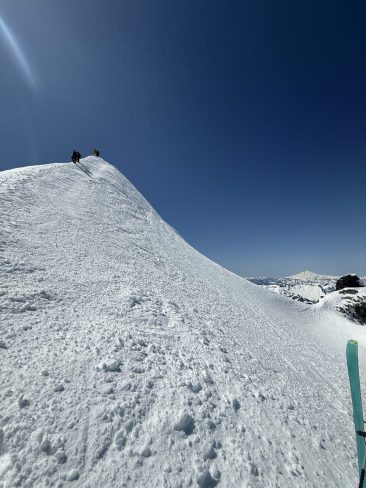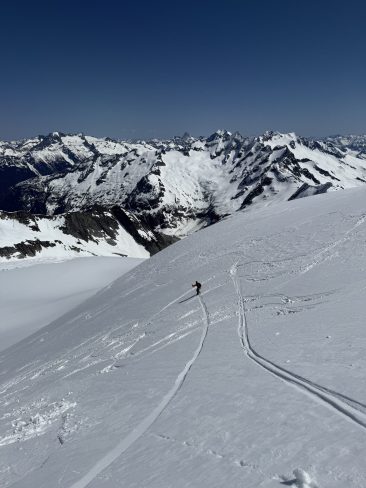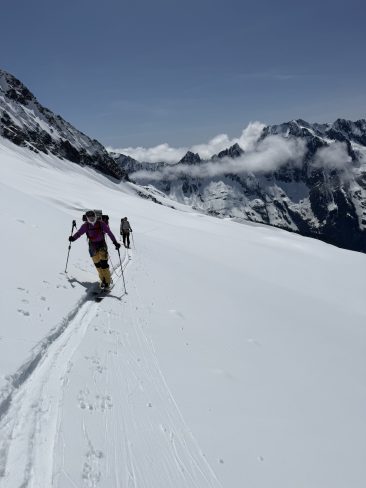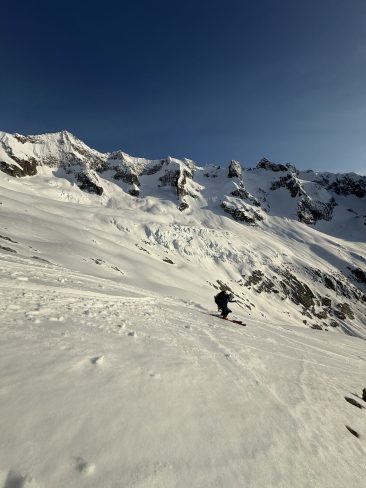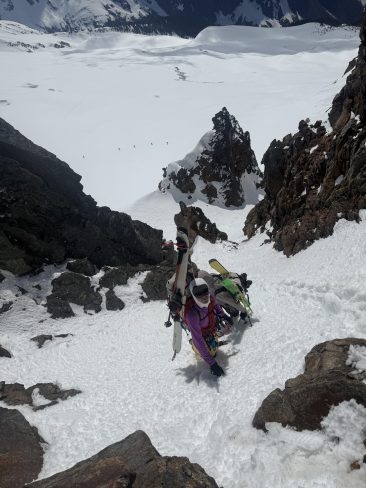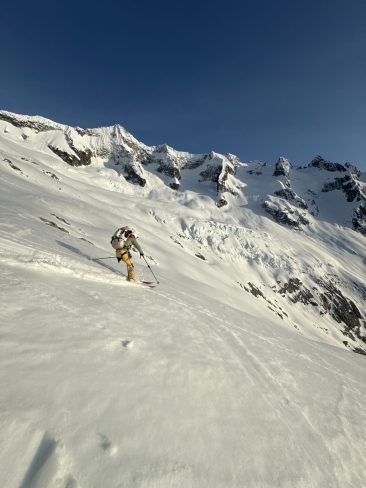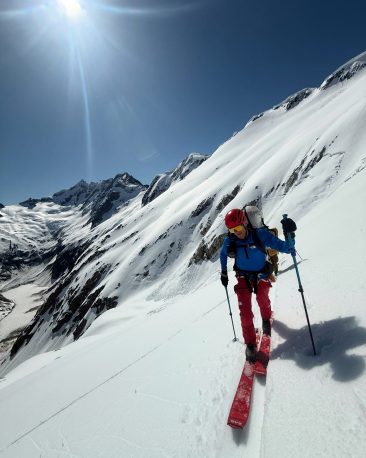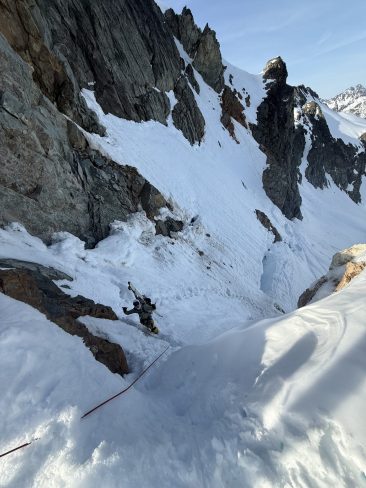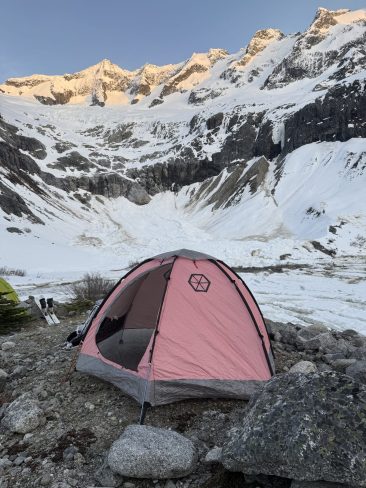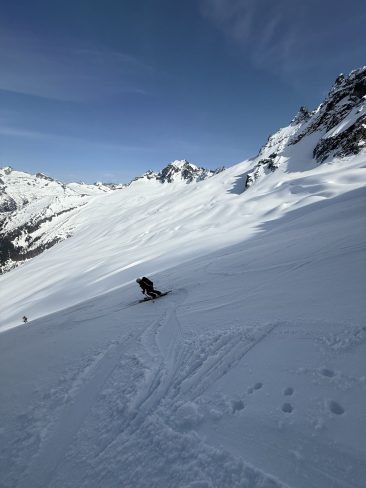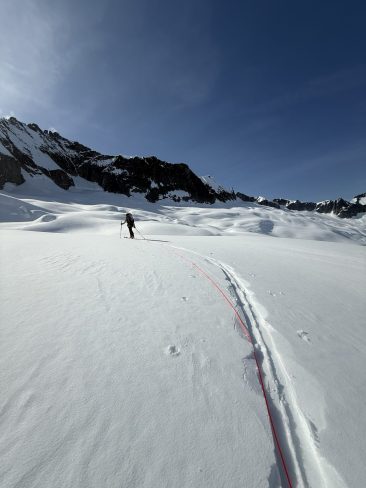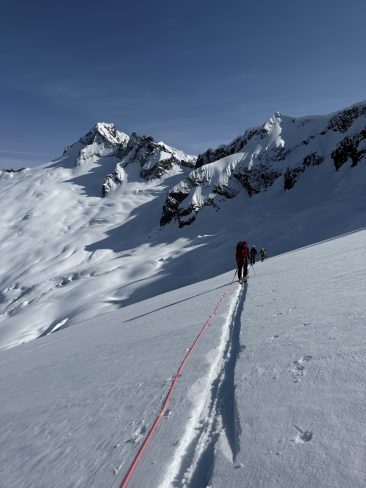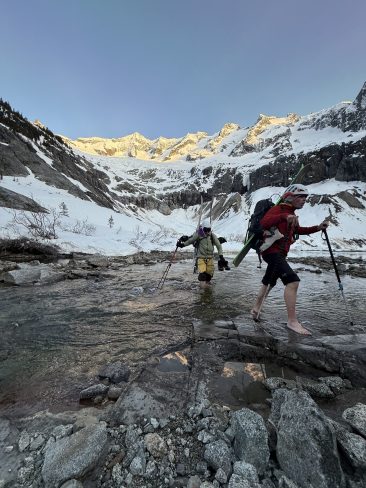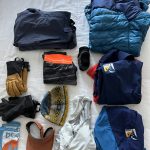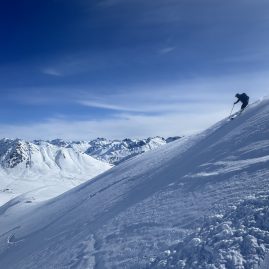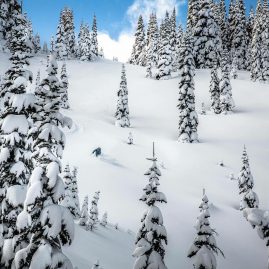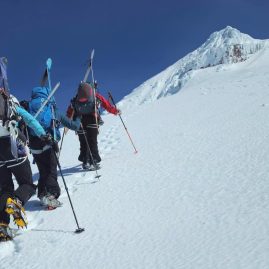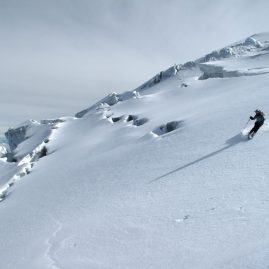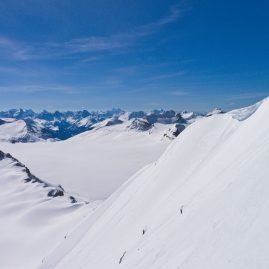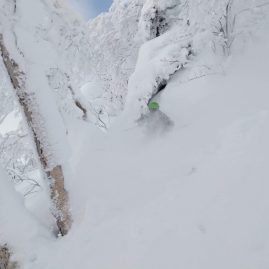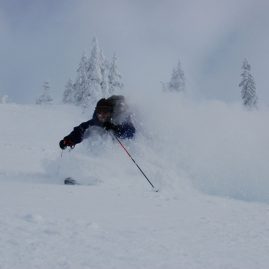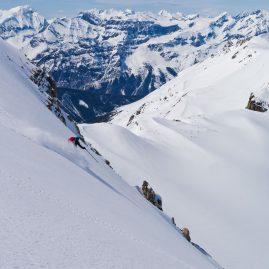The North Cascades in spring offer the best high alpine touring in the Lower 48 with the Legendary Forbidden Tour! The Alps have the Haute Route, the Cascades have the Forbidden Tour. Starting in Boston Basin, we traverse some of the largest glaciers in the Cascades. We circumnavigate Forbidden, Klawatti and Eldorado Peaks crossing 3 passes enjoying several 3-4,000 foot descents along the way. This tour takes you far away from the crowds of Whistler and Chamonix while offering up some of the most rugged terrain in the Lower forty-eight. By adding an extra day you can add a few more summits and descents such as Klawatti South Face, Eldorado Northeast Face, Dorado Needle and the Torment Couloir.
- Dates:2026 or call for Custom
- April 18-21 & Custom Dates (min 2:1)
- Duration: 4 Days Custom Programs available, call to a learn more..
- Level: Expert to Advanced
- Client Ratio: 3:1 Best if you sign up with a friend or two;)
- Cost:
- 4 Day – $1,395
- Included: All meals while on the mountain, tents, stoves, cook kits, group climbing equipment, and guide services
- Not Included: Ground transportation, airfare, transportation within Seattle, hotel accommodations, restaurant meals, gratuities for guides, and all personal items. A detailed equipment list will be sent to all participants.
Day 1 – Boston Basin Approach | 4,400′ ↑ | ~5 Miles (7 with road walk) | 6–7 hours
After a 6:30 a.m. orientation and gear check in Seattle, we drive to the North Cascades and begin our approach to Boston Basin. In early season, the gate at the Eldorado Trailhead is often closed, adding about 2 miles and 600 feet of gain on a scenic but uphill forest road walk. From there, the trail winds steeply through dense forest and into the alpine zone, with increasingly stunning views of Johannesburg Mountain and the Quien Sabe Glacier. We’ll ascend to a high camp nestled in Boston Basin around 6,000 feet—one of the most visually striking camps in the range, with towering granite faces, hanging glaciers, and cascading waterfalls surrounding us.
Day 2 – Forbidden Glacier Descent | 1,200′ ↑ / 4,000′ ↓ | ~4 Miles | 4–6 hours
We begin the day by climbing toward Sharkfin Col, using crampons and possibly a short rope section to access the notch. From there, a striking traverse across the upper Boston Glacier brings us beneath the north face of Forbidden Peak. We then loop around the east side of the mountain, passing over Forbidden Col and dropping onto the top of the Forbidden Glacier. With the hardest climbing behind us, we descend nearly 4,000 feet of open glacier and moraine terrain to reach Moraine Lake, a beautiful and remote zone.
Day 3 – Up to the Inspiration Glacier | 4,300′ ↑ / ~800′ ↓ | ~5 Miles | 6–7 hours
From Moraine Lake, we ascend the remote and rugged Inspiration Glacier, making our way toward Klawatti Col, gaining roughly 4,300 vertical feet. The climb is steady and scenic, weaving between crevasses and beneath the towering summit of Klawatti Peak. Once at the col, we set up camp with expansive views of the Isolation Traverse, Forbidden Peak, and the hidden reaches of the North Cascades. The afternoon offers options—ski a lap on the McAllister Glacier, climb toward Klawatti, or work on snow anchor and belay techniques. Depending on group energy and objectives, it’s also possible to exit the tour on this day via Eldorado.
Day 4 – Eldorado Summit & Exit | 1,200′ ↑ / 6,800′ ↓ | ~5 Miles | 6–8 hours
We wake early for a summit push of Eldorado Peak, ascending its gentle but exposed upper slopes to reach the knife-edge summit ridge at 8,868 feet. If conditions are favorable, we’ll ski directly off the summit—an unforgettable descent down massive glaciated terrain into Eldorado Creek. From there, we enjoy a long and rewarding ski out through classic North Cascadian terrain, weaving between trees, waterfalls, and boulder fields until we reach the trailhead and conclude the tour. This final day delivers a huge descent and a grand finale to one of the most varied and aesthetic ski mountaineering circuits in the Pacific Northwest.
Our recommended clothing system has four layers.
- Base layer: manages moisture and wicks perspiration away from your skin. (Polypro, capilene, driclime)
- Softshell: should be a durable, comfortable, insulating and wind/water resistant layer that breathes well.
- Hard shell: windproof, waterproof and breathable. (e.g. Gore-Tex, or similar)
- Insulating layer: should be down-fill or synthetic-fill and fit over all layers. (e.g. down, primaloft or polarguard)
These four layers are usually sufficient for most people, but if you tend to be colder bring one extra medium-layer that would be ideal for extra warmth around camp, such as a vest. When deciding what to pack, remember to bring enough clothes and accessories to ensure your safety and comfort, while not over-burdening yourself with items you probably won’t use.
Climbing/Ski Gear
- Adjustable Ski poles with powder (big) baskets*
- Skis or splitboard.Skis should be equipped with alpine touring bindings or telemark bindings. We prefer splitboards w/ skins because you do not need snow shoes.
- Alpine touring, telemark, or snowboard boots
- Snowshoes for snowboarders
- Skins with glop stopper (skin wax)
- Avalanche Beacon This needs to be Triple Antenna.
- Shovel Small collapsible style
- Avalanche Probe 265cm or longer
- Helmet for riding and climbing adjustable to fit over hats
- Ski Crampons Required for all ski mountaineering trips
- Alpine climbing harness Must have adjustable leg loops and fit over all clothing and can be put on with ski boots
- Ice axe Lightweight
- Crampons with anti-ball plate * Must be fit to boots prior to trip,
Crevasse Rescue Equipment Kit*:
- 4 Locking carabiners Large, pear-shaped carabiner is best, screw gate type recommended
- 4 regular carabiners (e.g. small wire gate are recommended)
- 1 double length sling
- 1 single length sling
- 1 Cordelette 6 mil 18-20’(6-7 meters)
- 1 12” Prussik or Hollow Block*
- 1 Microtraxion & Tibloc*
- Lightweight base layer T-shirt
- 1 long sleeve Sun Hoodie or shirt Lightweight, light colored for sunny days
- Soft Shell
- 1 Down/synthetic jacket with hood
- 1 Hard shell jacket with hood Waterproof and breathable. roomy enough to fit over multiple layers.
- 1 pair liner gloves Thin wool or polypropylene
- Shell gloves or mitts
- Warm hat Wool or synthetic
- Balaclava or Buff
- Shade hat or baseball cap
Lower Body
- 2 pair heavy wool/synthetic socks Check boot fit with liner and wool socks on
- 1 pair lightweight long underwear Polypropylene or Capilene
- Soft shell pants
- Shell pants Waterproof/breathable with full side zips, Gore-Tex or equivalent is best
Sleeping Gear
- Sleeping bag Rated to at least 20º F. Line the stuff sack w/ plastic bag.
- Sleeping pad 1 closed cell foam and Air mattress/Neo-Air for extra warmth and comfort.
Backpack
- Internal frame pack 3500-4500 cubic inch capacity able to carry snowboard/skis
Miscellaneous Equipment
- Goggles and Sunglasses 100% UV protection
- Personal first aid repair kit Basics: moleskin/blister kit, Band-Aids, first-aid tape, ibuprofen, personal medications, spare parts for bindings and batteries etc.
- Lip balm At least SPF 20
- Sunscreen At least SPF 40
- Headlamp lightweight LED
- 2 water bottles 1 liter wide-mouth Nalgene and 1 bottle holster, or
- Hydration bladder With drinking tube and 1 Nalgene bottle
- Bowl and spoon Plastic, small Tupperware works well. Lexan spoons are best.
- Toiletry kit Be sure to include WAG Bag or toilet paper stored in a plastic bag.
- Bandana
- Hand wipes
- 1 small stainless steel thermos (Optional)
- Favorite snack foods (no more than 2 pounds)
WHO WILL MY GUIDE (OR GUIDES) BE?
We are small company who enjoy working together in the mountains as well as highly skilled professionals who hold current Wilderness First Responder certification and are proficient in technical rescue and evacuation skills. Our guides are dedicated to the world of alpinism, many having first ascents and hold professional certifications with the AMGA in the rock, alpine, and ski disciplines. The AMGA is part of the IFMGA, which is the international body of certified mountain guides.
HOW MUCH SHOULD I TIP MY GUIDES?
Tipping is considered standard practice in the guiding industry. Tipping amounts vary, often 10% of the course cost is a good rule-of-thumb, so $20-30 per day per person/per guide is average that works well for the guides without a serious blow to your wallet. If you feel that the program was exceptional or substandard the tip can reflect that.
CAN I RENT EQUIPMENT FROM BCAG?
No, we recommend renting from Ascent Outdoors or Cripple Creek where they have a full selection of rentals.
HOW HEAVY WILL MY PACK BE?
You will be required to carry a portion of the group gear and food in addition to your personal gear. This should be taken into consideration when deciding what you will bring. A good rule of thumb is to try to keep your pack weight below 40 pounds, which will allow for extra items to be carried of the group equipment.
WHEN DO I NEED TO PAY THE BALANCE OF MY TRIP?
For Scheduled Domestic Courses and Climbs: Your balance is due 30 days from trip departure. Payable by credit card, check, Venmo or Paypal.
WHAT HAPPENS IF I NEED TO CANCEL MY TRIP?
If you should decide to cancel your trip, BCAG must be notified in writing. Your trip will be cancelled from the date we receive written notice. You will be assessed a cancellation fee according to the following schedule:
90 to 31 days from trip departure – 50% of trip cost
30 days or less – 100% of trip cost
WHAT HAPPENS IF I WANT TO CHANGE THE DATES OF MY TRIP?
Schedule changes are subject to a $100 fee per person up to 2 weeks out and $150 less than 14 days from the start of the trip and may not be possible. If conditions or circumstances preclude running a scheduled program we reserve the right to make the decision as to whether the program will be canceled, rescheduled, or an alternative provided.
WHAT HAPPENS IF BC ADVENTURE GUIDES HAS TO CANCEL MY TRIP?
In the rare circumstance where we need to cancel a program you can reschedule without a fee or receive a refund on your deposit. If circumstances arise that force us to cancel a program that is already in progress we reserve the right to decide whether a refund or credit, at a prorated rate, will be issued. We are not responsible for cancellation fees or costs arising from your changed or cancelled flights, lodging, or other arrangements. We strongly recommend obtaining trip cancellation insurance from your travel agent.
DO I NEED TO PURCHASE TRIP INSURANCE?
BCAG highly encourages the purchasing of trip cancellation and travel insurance on domestic trips and requires it on international trips. Europeans and Canadians use it because travel insurance provides coverage for trip cancellation and interruption, travel delays, loss of baggage and travel documents, baggage delays, medical expenses and emergency assistance. To avoid any financial hardship that an unexpected cancellation or interruption could cause,
Trip Cancellation/Interruption costs about 5% of your trip cost and it’s worth the peace of mind! If you find that you are not already covered for any of the above circumstances you have options!
BCAG has an account with Global Rescue, the world’s leading membership organization providing integrated medical, security, travel risk and crisis response services to our travelers worldwide. They can provide you with medical and evacuation coverage.
https://partner.globalrescue.com/bcadventureguides/index.html
WHEN SHOULD I PLAN TO LEAVE A RETURN HOME?
We often get this question because most people need to know how much total time they need to take off work. Our Northwest trips begin at 7 am in Seattle on the first date of your trip. Therefore, you will want to arrive the day before your climb or course begins. Our return to Seattle on the last day typically extends into the early evening with the descent and drive back. We suggest you make a hotel reservation for the night of the last day or a late red eye flight to return home on the day following the end of your course or climb.
WHAT IF I WANT TO ARRIVE EARLIER OR DEPART LATER THAN THE TRIP DATES?
No problem. There is a lot to see and do in the Seattle area and we would be happy to recommend our favorite attractions, restaurants, and day trips.
WHERE SHOULD I STAY IN SEATTLE?
There are many other hotels nearby to choose from as well and suggest one that includes parking and possibly north of downtown.



